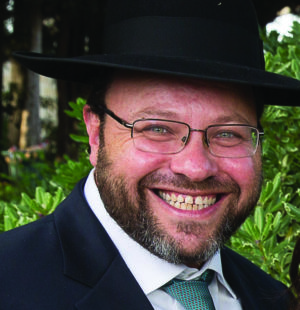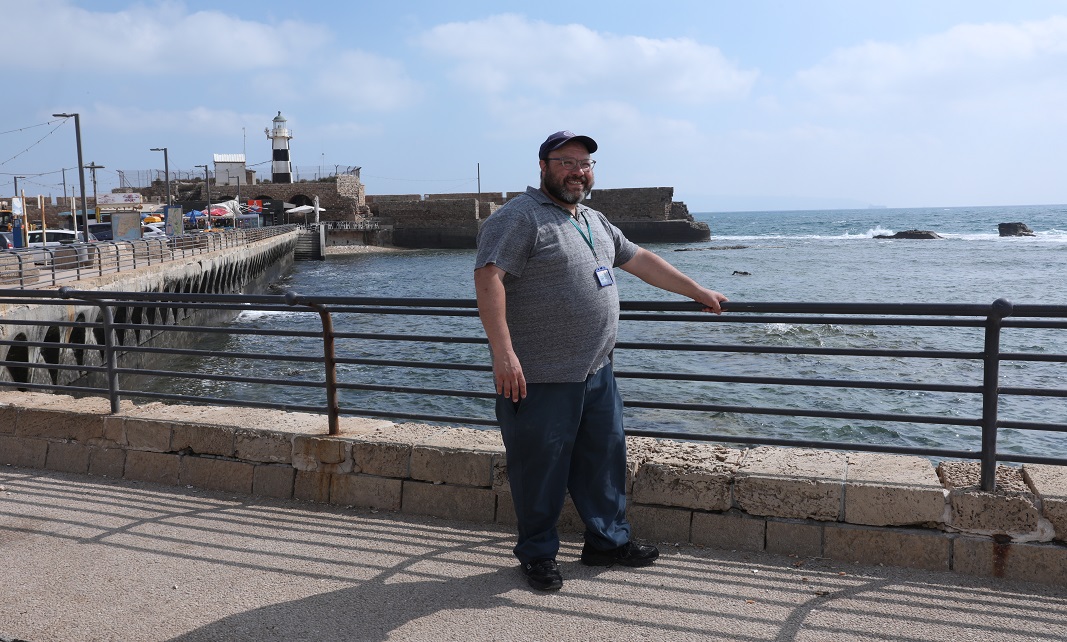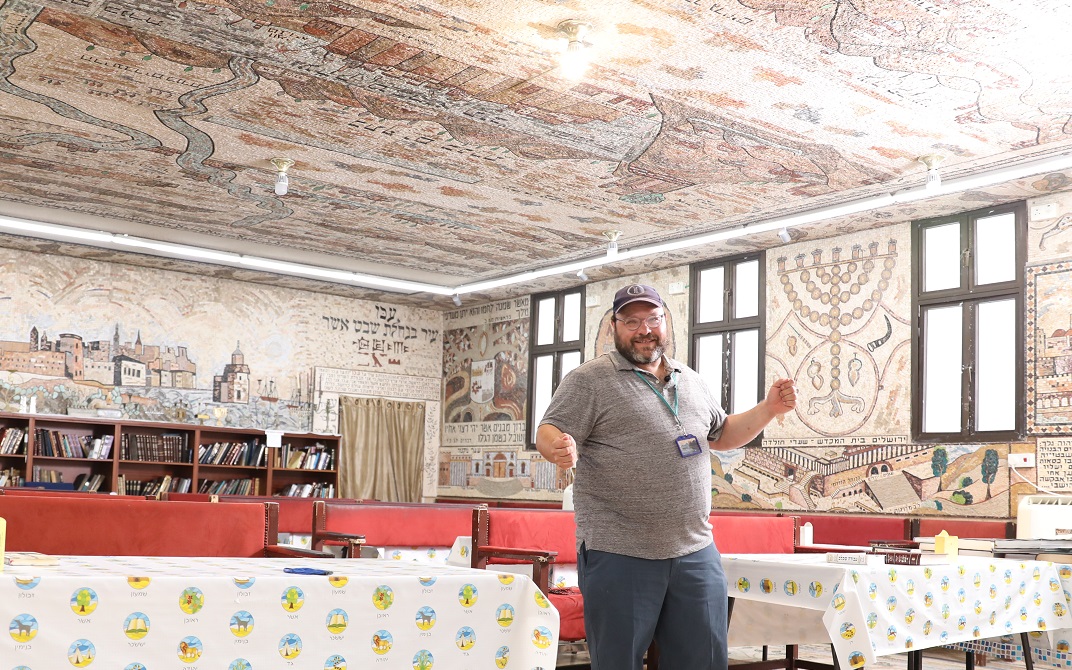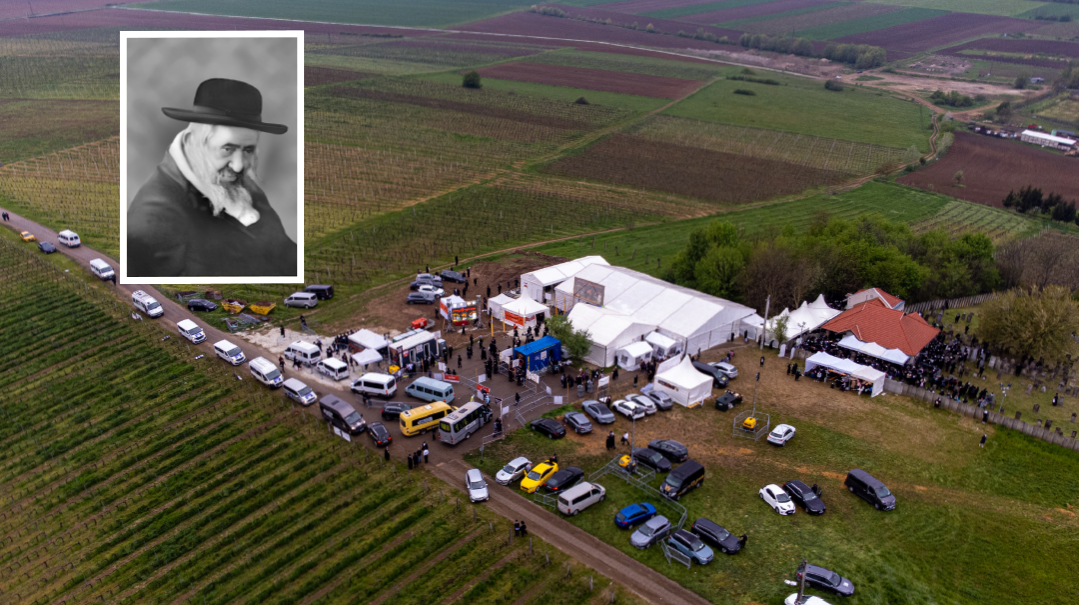Port in a Storm

Akko might still have a reputation as a poor, rundown city, but the magic those old-time conquerors understood is still pounding on the rocks

Photos: Menachem Kalish
"W
hat’s there to see in Akko?”ourists often ask me when I suggest a visit to this very underrated tourist city. The truth is, in the past I would probably have agreed with them — all I knew was that Akko was basically a slum city that really didn’t have much to offer the discerning frum tourist. It was rundown, with lots of mosques and churches and nary a mehadrin restaurant. So this ancient port city, the primary gateway to Eretz Yisrael for millennia — with its rich history, inspiring stories, and ancient cobblestones — patiently waited for her children to return and crown her with the honor and respect she deserves.
Today Akko is doubly recognized as a United Nations Educational, Scientific and Cultural Organization (UNESCO) World Heritage City, one of only a handful of UNESCO’s 1,100 sites worldwide to have that distinction. Israel itself — despite the fact that it’s a living history book — has only eight sites (of which Jerusalem, Chevron, and Kever Rachel are not included, as they are not recognized by the UN as being part of Israel). But UN ratings are not what draw frum tourists — they want history, inspiration, kedushah, and someplace to eat, and Akko has all of that and more.
It’s said that the name of the ancient city, on whose seawall the Mediterranean waves pound and crash, comes from the pasuk in Iyov (38:11) describing either Hashem’s commanding the limits of the ocean, or referring to the Mabul, as the Yerushalmi learns, saying “Ad poh — Until here you may come but no further.” “Ad poh” became the similar “ad koh” and thus, Akko got its name.
When Bnei Yisrael entered Eretz Yisrael, this was meant to be the inherited portion of the Tribe of Asher. Looking around as we enter the city and see the abundant olive trees, one can appreciate the realization of the brachos of Yaakov and Moshe to this shevet — that their bread should be rich with oil and their feet anointed with it. Asher, though, did not conquer this area in the end, and thus its status of kedushah, established by the first conquest in the times of Yehoshua, was unclear. It is for this reason, the Ramban suggests, that Rabi Abba, the great fourth-century Amora, would kiss the rocks of Akko upon arriving here and the Tanaim would depart from one another from this city. This was the gateway to and from chutz la’aretz — the Ellis Island of Eretz Yisrael — and its precious stones evoked the deepest emotions of coming home.
The Protector
Entering the city, you can’t miss the large tel — a hill built on the ruins of a civilization — with the sculpture of a little man with his hand in his vest, riding a horse and wearing a triangular-shaped hat. When I ask school groups who it is, some of the sweet yingelach scream “Haman!” But no, this short would-be world conqueror was none other than Napoleon Bonaparte, who came to Eretz Yisrael in 1799 after conquering Egypt on his path to world domination. After conquering and pillaging Yaffo, Akko was his next stop. For two months he tried to lay siege on the city, and the Ottoman governor, El Jazzar — known as the “Butcher of Akko” for his predilection to ride around the city waving his axe around the heads of his suspected enemies — was terrified. Napoleon’s brutal reputation of decimating his conquered cities preceded him. Yet Jazzar had the benefit of a brilliant Jewish adviser, Chaim Farchi, his right hand-man and one of the most influential Jews in the Middle East at that time (although he lost his left eye, ear lobe, and tip of his nose on one of Jazzar’s rampages). Farchi advised El Jazzar to build a second siege wall within the first one, so that even if Napoleon came through the first, they would hit him off at the second. (Both walls are still standing.) Sure enough, that’s what happened. Napoleon, caught unaware, retreated to Egypt and pretty much threw up his hands at the idea of conquering the Middle East.
Chassidim, of course, attribute the defeat of Napoleon to the merit of the great tzaddik that was caught in the city at the time of the siege. Waiting to sail home to Uman after his eight-month pilgrimage to Eretz Yisrael, Rebbe Nachman of Breslov found himself trapped in the city. Although for many the situation might have seemed hopeless, Rebbe Nachman’s teaching of “ein yeiush ba’olam klal” carried the day.
Call That Liberation?
In the old city, our virtual tour begins overlooking the Crusader Halls. During the Second Beis Hamikdash era, Akko was a large port city that was both Greek and Roman. Yehudah Maccabi conquered the city, though tragically not long before, his brother Yonasan was captured and murdered here. The city, though, reached its zenith in the 12th and 13th centuries, during the period of the Crusaders. After the Crusaders, led by Richard the Lion Hearted, were trounced by Salaadin in 1187, they made a compromise: The center of the country would be under Muslim control and the coastline would be ruled by the Crusaders, whose mission was to free the Holy Land from the “infidels.” Akko thus became the capital of the Crusader kingdom, and with pilgrims from Europe flocking to Israel, it became the primary source of income for the Vatican.
We go down the large staircase to the underground Crusader city that was once here. The Crusader empire came to an end in 1291, when it was conquered by freed slaves who had rebelled, called Mamluks. It wouldn’t be until the 1700s that the city would be rebuilt on top of the former ruins by the Ottomans. The underground city remained buried until the 1950s, when excavations began.
I don’t bring tourists down here into these huge halls, refectories, and living quarters too often. Frankly, I’m not a fan of the Crusaders, who massacred thousands upon thousands of our ancestors, which some historians say may have been 30 percent of the Jewish population of Europe. Although they tend to be romanticized as an ideological fighting force, the Crusaders were in fact a filthy lot, bathing no more than once a year, and eating with their hands which they’d wipe on the equally dirty passing dogs. They were drunk most of the time, the miscreants whom the Pope wanted out of Europe and sent to the Holy Land to liberate the territories. It’s suggested in seforim that many of the minhagim of aveilus during Sefiras Ha’omer were instituted after the Crusades, as it was during the period from Pesach to Shavuos when the Crusades were mounted. Walking through these halls is as painful as walking through the barracks of the Nazi commandants in the camps of Europe.
Long Before
Heading back up to Akko’s old city, we can’t help notice that it’s almost entirely Arab. Yet the residents here are generally peaceful, especially as tourism is a big part of their livelihood. As we walk through the streets we’re greeted with many Salaam Aleikums. (There are several mixed pockets throughout Akko, where Jews have established yeshivos and kollelim side by side their Arab cousins.) We stop at the Turkish-bathhouse historical museum, where we can easily conjure up the incredible story told in the Gemara of Rabban Gamliel who was right here using the bathhouse when he was accosted by a Roman, who asked him how he could use a bathhouse that so visibly had an idolatrous statue on top of it. Rabban Gamliel answered that he’d been coming here long before the statue was here. It’s always something to keep in mind in these parts: We were here first.
Forty Best Years
We move on to a later chapter in history, as we arrive at the shul of the Ramchal, one of the city’s prominent rabbanim of the 1700s. We even get a sneak peek into the as-yet unopened Jewish heritage museum that’s being completed next door to the shul. It’s a former house that has been restructured with little enclaves with films and multimedia about the many great Torah figures who lived here in Akko, and will include booths where one can access the various works of the Ramchal and other seforim with a connection to the city. And as a boost to the city’s Jewish atmosphere, tour organizers have told me that about 30 percent of the homes around the Ramchal shul have been quietly bought by Jewish investors in the last two years, for use as tzimmers and vacations suites.
Rav Moshe Chaim Luzzato, born in Italy in the early 1700’s, was one of the most brilliant and prolific writers and scholars of his time. His most famous works are Mesilas Yesharim and Derech Hashem, but in fact he wrote over a hundred seforim and kuntreisim — on everything from machshavah and mussar to Kabbalah, grammar, science, mathematics, and astronomy. He wrote plays and novels and even composed his own sefer Tehillim. Yet, the Ramchal, who had the misfortune to live right after the Shabbtai Tzvi false-messiah debacle which took thousands of Jews down with it, was suspected to be a threat as well. He was put into cheirem, his seforim were burned, and he was chased out of Italy and fled to Amsterdam. Frustrated by the condition that he was forbidden to teach Kabbalah, he left Holland for Eretz Yisrael and settled in Akko in 1743. Just three years later, he and his family died in a plague.
His shul was taken over by the Ohr Hachaim Hakadosh before the latter moved on to Jerusalem, but the building was then razed by the city’s Muslim ruler, who built a mosque on top of it. To his credit, in its place the Jews of Akko received a small building near the mosque, which is what’s known as the Ramchal shul today.
Even in death, it seems there is mystery and controversy. People go to the Ramchal’s tomb in Teveria, which is right next to the grave of Rabi Akiva. However, just a few kilometers from Akko, there’s an old Jewish cemetery in the Arab village of Kfar Yasif, where there is a kever with his name on it as well. This cemetery was built outside of Akko in order to be certain that those put to eternal rest would certainly be within the borders of kedushah of Eretz Yisrael. It makes more sense that the Ramchal would have been buried closer to home than on the other side of the Galil in Teveria, It seems that the Teveria tradition is based on the idea that the Ramchal, who passed away at age 40, was moved to Teveria because he shared the same shoresh neshamah as Rabi Akiva, who required a tikkun for the first 40 years of his life that he was an am ha’aretz.
But the Ramchal wasn’t the only gadol who graced this city. Akko was the central city of Torah during the period of the Rishonim and beyond. It was home for a time to Rabi Yehudah Halevi, the Rambam, Rabi Yonasan M’Lunil and Rabi Shimshon M’Shantz, one of the Baalei HaTosafos and student of Rabbeinu Tam who arrived here with 300 students from England and France, establishing the first yeshivah of the Rishonim in Eretz Yisrael. In the 1200s, Rav Yechiel M’Paris arrived when he fled Spain after winning the debate against the apostate Nicholas Donin and the subsequent burning of the 24 wagonloads of Talmud. The stature of the rabbanim of Akko was held in such esteem that the Rashba writes in one of his response, “The minhag of all of the chachmei Eretz Yisrael and Bavel who have questions is that nothing can be decided without the approval of the rabbanim of Akko.”
Ultimate Sacrifice
One of the most dramatic and heartbreaking stations is the Museum of Underground Prisoners. The building, a former Ottoman castle built on the remains of a Crusader fortress — complete with guard towers and a surrounding moat — served as the central prison for the northern region under the British Mandate — who had no problem hanging prisoners, including Jewish prisoners from the pre-state underground resistance movements
We enter the prison and note the rooms where prisoners’ personal items were confiscated, and where they were given uniforms and mattresses made out of shmattehs. The cold, dark, damp cells, with a bucket for a latrine, were miserable. While the various Jewish pre-state underground organizations had their internal disputes and different approaches that ranged from diplomacy to direct attacks on British forces, the British didn’t much care or differentiate, and dozens of Jewish prisoners from the Haganah, Etzel, and Lechi were incarcerated.
As we walk through the cells, we pause at a small room which served as a shul. It was here that the tzaddik of Jerusalem, Rav Aryeh Levine, would regularly visit the prisoners and give them chizuk. He would cry with them, he would fast for them, and bring siddurim and tefillin, encouraging them to have hope for the yeshuas Hashem that was sure to come. Although Reb Aryeh was from the Old Yishuv and the prisoners mainly secular fighters, he treated them like his own children.
When Reb Aryeh once visited the prisoners on Chol Hamoed Pesach, they told him they wanted to open up the door for Eliyahu Hanavi during their makeshift Seder, but it was locked. Reb Aryeh told them that the door for Eliyahu would always be open. They just needed to learn how to turn the key. And so they did. They planned an escape.
On May 4, 1947, they put their escape plan into action, when Etzel forces, whose jeeps were disguised as electrical-repair vehicles, planted explosives alongside the prison windows. The plan was that 41 prisoners selected by lottery would escape, while the rest of the prisoners would create diversions by setting off explosives on the Arab side of the prison (they’d managed to smuggle in explosives inside fruit, cans of jelly, and bottles of oil). At the predetermined synchronized time, all the explosives would go off and the prisoners would jump out the window to the waiting jeeps and zoom away.
Six released prisoners were killed in a battle that ensued outside the prison walls against British forces, but when the smoke cleared, it became evident that 27 prisoners had managed to escape. Eight of them were re-captured and three of them sentenced to death by a British military court.
Our next stop in this former prison is the gallows room, where nine Jewish prisoners in total were hung. Reb Aryeh visited the prisoners here and in his diary recorded the conversation he had with the three escapees who were to meet their deaths on these gallows. He asked them about their morale, and they told him how inspired they were by the stories he taught them of Rabi Akiva and of the various periods of shmad where Jews gave their lives for the sake of Hashem. Although they knew they could never reach those high levels, they hoped their fight to redeem Eretz Yisrael for the Jewish People would have spiritual meaning. Reb Aryeh looked at them in silence and later wrote: “What could I say to them? Go to our father Avraham, your spirits will surely rise to the sphere of the Avos when you leave This World.”
Floor to Ceiling
I always like to conclude my Akko tour with an amazing shul in the new city: Kehillah Ohr HaTorah — the Tunisian Synagogue. About 60 percentof Akko’s population of 56,000 are Jewish, and Ohr HaTorah is the oldest “modern” shul, established right after the War of Independence in 1948. Many of the Arab residents had fled to join the Arab legion, and the new Israeli government, wanting to settle the new city, encouraged olim from Tunis to settle here. Tzion Badash, who was their representative and no more than a bochur at the time, informed the government that they could not move into a city that had no shul, and so the government gave them this empty field. Tzion, who passed away recently, told me, “It’s been 70 years and we’re still building it.”
Tzion had a love for Jewish history, for Eretz Yisrael, and for Klal Yisrael, and those three passions came together in the ancient decorating form of mosaics, found in almost every shul from the period of the Mishnah and Talmud. Tzion, I’ll admit, got a bit carried away. The shul building is four floors of floor-to-ceiling mosaics. Each stone, Tzion would tell me proudly every time I’d visit, was indigenous to Eretz Yisrael and all of the labor was done by Jewish workers.
The shul is now run by Tzion’s daughter Yaffa. When Tzion was alive, he would never tire of sitting with tourists sharing his personal history. Tears would come to his eyes as he would tell us how, when he first landed here on an illegal boat and was handed an old Czech rifle, he lifted that gun above his head and recited shehechiyanu. He would share how he merited to have children, grandchildren, and great-grandchildren who live in Eretz Yisrael, and boasted that he never got a passport. “Why should I?” he would say. “After 2,000 years in the golah, why would we want to leave?”
As I walk out of the shul and remember Tzion, I can feel his passion for Eretz Yisrael anew — it’s the passion of Rabi Abba kissing the rocks of Akko, of all those throughout the centuries who dreamed of landing at this port with the Mediterranean tide pounding the bulkhead. It’s the time of year that we’re meant to feel that longing for the geulah sheleimah, and I thank Hashem that meanwhile, He has given me the zechus to live in His courtyard. Is it time to give up my passport too?
(Originally featured in Mishpacha, Issue 820)
Oops! We could not locate your form.







